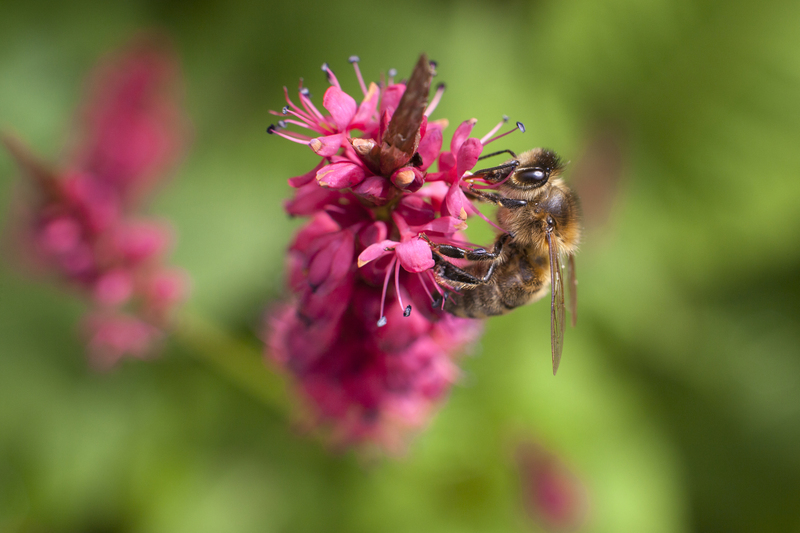Transforming Windy Areas into Lovely Gardens
Posted on 04/09/2025
Transforming Windy Areas into Lovely Gardens: A Comprehensive Guide
Do you live in a breezy or blustery region? Does the wind whistle through your yard, making traditional gardening a challenge? You're not alone. Transforming windy areas into lovely gardens is possible with the right strategies, smart plant choices, and creative design techniques. In this guide, we cover everything you need to know to turn a windswept plot into a lush, welcoming retreat for both people and wildlife.

Understanding the Challenges of Windy Places
Gardening in windy areas comes with unique obstacles. Strong gusts don't just ruffle leaves--they can also:
- Dry out soil and plants rapidly, leading to water stress.
- Cause physical damage to delicate stems, flowers, and young trees.
- Make it harder for pollinators, like bees and butterflies, to visit flowers.
- Batter garden furniture and make outdoor spaces less inviting.
Why Not Embrace the Breeze?
While the wind may initially seem troublesome, it can actually be helpful in certain circumstances:
- It reduces humidity, which prevents many plant diseases.
- It keeps pests like mosquitoes at bay.
- It aids in seed dispersal for some plants.
Step-by-Step: Transforming Breezy Sites into Beautiful Gardens
1. Assessing Your Site's Wind Exposure
Before you can start creating a garden sanctuary, you need to understand how the wind moves across your space. Are there certain times or seasons when the wind is stronger? Which direction does it usually come from? What structures currently block or funnel the wind?
- Spend time in your garden at different hours and in all seasons.
- Take **notes on where plants suffer the most, and which areas feel most exposed.
- Use windbreak maps and weather data (often available from local meteorological services).
Tip: Walk around with a weather vane or simply observe movement of grasses, flags, or smoke to determine prevailing wind patterns.
2. Designing with Wind in Mind: Windbreaks and Shelters
To transform windy patches into inviting gardens, creating shelter is usually the first step. Effective windbreaks reduce wind speed, provide microclimates for delicate plants, and make outdoor areas more comfortable.
- Living Windbreaks: Hedges, trees, and dense shrubs are popular choices. Planting in rows perpendicular to the prevailing wind direction will slow and redirect gusts.
- Structural Shields: Fences, trellises, pergolas, or lattices can be positioned strategically. Partial barriers (that let some air filter through) work best--solid walls often create turbulence downwind.
- Earth Mounds: Berms and raised beds can act as low-level shelters.
*Combine both living and structural windbreaks for a layered, visually appealing look that also supports wildlife habitat.*
3. Choosing the Right Plants for Windy Gardens
Plant selection is crucial when turning gusty gardens into lush retreats. Focus on varieties that are inherently tolerant of wind and able to thrive in harsh, exposed climates.
- Tough, flexible stems - Grasses, bamboo, and certain shrubs bend rather than break.
- Small, waxy, or hairy leaves - These minimize water loss caused by constant airflow.
- Dense root systems - Deep or wide-spreading roots help anchor plants against wind forces.
- Low-growing or mounded forms - These present less surface area for winds to catch.
Recommended Wind-Resistant Plants:
- Grasses: Miscanthus, feather reed grass (Calamagrostis acutiflora), fountain grass, native prairie species.
- Shrubs: Oleaster (Elaeagnus), sea buckthorn, escallonia, Viburnum species, hawthorn, mahonia, boxwood.
- Trees: Scots pine, black locust, hawthorn, alder, rowan, Russian olive, juniper.
- Salt- and wind-tolerant perennials: Yarrow, lavender, Russian sage, sedum, geranium, daylilies.
*Native plants are highly recommended because they've evolved to handle the local climate and winds naturally. Consult a regional horticultural expert for the best adapted species.*
4. Soil Care and Water Management in Windy Gardens
The wind's drying effect can make proper soil moisture management a major issue. Incorporate these practices to ensure your plants remain healthy and hydrated even on windy days.
- Mulch generously with bark, wood chips, or gravel to retain soil moisture and insulate roots.
- Amend your soil with organic matter (compost, leaf mold) to improve its water-holding capacity.
- Install drip irrigation or soaker hoses, which are better than sprinklers (wind scatters spray and wastes water).
- Wind-prone sites might require windscreens for young transplants to reduce water loss until roots establish.
Pro Tip: Raised beds dry out faster in windy spots but can be an advantage if drainage is a concern.
5. Creative Garden Design for Beauty and Shelter
Transforming exposed sites into lovely, inviting gardens goes beyond just survival--great design makes these spaces irresistible.
- Layer plantings vertically: Use tall windbreak hedges, medium shrubs, and low groundcovers to create stair-step protection and visual interest.
- Curved, sinuous paths and beds help "trick" wind, breaking up its flow across the garden.
- Cluster plants: Grouping together creates microclimates and gives delicate species some reprieve.
- Wind-activated features: Consider planting ornamental grasses, wind chimes, mobiles, or spinning garden art to celebrate gentle breezes rather than hide from them completely.
- Sun-traps and nooks: In the lee of windbreaks, position seating, terraces, or vegetable patches for maximum warmth and calm.
Enhancing Wildlife and Biodiversity in Wind-Exposed Gardens
A windy garden doesn't have to be bare or inhospitable. Many birds, pollinators, and beneficial insects thrive in "wild" gardens with a mix of shelter, nectar, and berries. Enhance your new landscape by:
- Including flowering hedges or native shrubs to attract bees and butterflies.
- Adding birdhouses and bat boxes on the sheltered sides of structures.
- Using a mix of textures, heights, and densities for richness of habitat.
- Leaving untidy corners with brushwood or stacked logs for overwintering insects.
Overcoming Common Problems When Gardening in Windy Locations
Even the hardiest gardeners can face setbacks in wind-prone landscapes. Here are solutions for common challenges:
- Breakage: Stake young trees securely and use soft ties. Trim back tall, top-heavy perennials before storm season starts.
- Soil erosion: Dense groundcovers (creeping thyme, sedum) or mulch layers reduce bare soil exposed to scouring winds.
- Salt spray near coasts: Wash salt-sensitive plants with a gentle hose spray after storms, and prioritize salt-tolerant species.
- Wind-borne debris: Keep paths clear and maintain structural windbreaks with regular inspections for wear and safety.
Low-Maintenance and Climate-Smart Solutions for Windy Gardens
Modern approaches to designing stunning gardens in windy locations also factor in sustainability and low-input care:
- Perennial plantings: Lower maintenance, deep-rooted, and resilient to extreme weather.
- Rainwater harvesting: Use storage barrels to supply supplemental irrigation during dry, windy spells.
- Permaculture techniques: Design with swales, wind-pruned living fences, and edible hedgerows.
- Naturalistic planting style: Favors mixed species, shapes, and local ecotypes for easier adaptation and ecosystem health.
Case Study: Coastal Wind Garden Transformation
Let's look at a real-world example. A homeowner on a windswept ridge overlooking the ocean wanted a lush garden filled with color and fragrance. The site faced salt spray, fierce winter gusts, and shifting, sandy soil.
- Step 1: Rows of salt-tolerant escallonia and griselinia were planted as the first windbreak.
- Step 2: Mounded beds, rich in compost, were built inside the protected zones.
- Step 3: Hardy perennials--lavender, sedum, sea thrift--were massed for color and movement.
- Step 4: Stone paths meandered, with benches tucked against the "lee" of hedges for peaceful, sheltered seating.
The result? A buzzing haven for wildlife, blooming for most of the year, and an outdoor living space even on blustery days--a true transformation.
Final Thoughts: From Blowsy to Beautiful
Turning windy patches into lovely gardens is a rewarding challenge for creative and resilient gardeners. By understanding wind patterns, employing smart design, choosing the right plant varieties, and nurturing your landscape with care, you can foster a flourishing, alluring retreat--even in the harshest of breezes.
- Observe and adapt - Every windy site is unique; let your garden evolve with experience.
- Prioritize shelter and resiliency - Mix living and built windbreaks and favor tough, local plants.
- Welcome wildlife - Your garden can support bees, birds, and other pollinators when appropriately designed.
- Find beauty in movement - Grasses, chimes, and even ribbons of color celebrate the energy that wind brings.
*Ready to start transforming your windy area into a beautiful, thriving garden? Take the first step--assess your microclimate, think creatively, and let the wind inspire your unique landscape design!*

Frequently Asked Questions about Gardening in Windy Areas
What is the most important step in creating a wind-resistant garden?
Establishing effective windbreaks--both living (like hedges and trees) and structural (such as fences or trellises)--is crucial to reduce wind speed and protect plants.
Can you grow vegetables in a windy garden?
Absolutely! Many vegetables, such as kale, chard, carrots, and onions, tolerate wind well, especially when given shelter. Use windbreaks and choose lower-growing crops for best results.
Should I avoid flowers in exposed gardens?
No, but select wildflower mixes, hardy perennials, and sturdy annuals with strong stems. Mass planting and mixed borders help shield more delicate blooms.
How can I enjoy my garden even on windy days?
Create protected seating areas behind windbreaks or within courtyards. Incorporate sensory elements like fragrant plants and wind sculptures for an immersive experience.
Conclusion
Gardening in wind-swept spaces requires a blend of resilience, innovation, and appreciation for the elements. With careful planning and bold plant choices, you can transform even the windiest area into a vibrant, welcoming sanctuary. Embrace the breeze, and watch your garden thrive!

